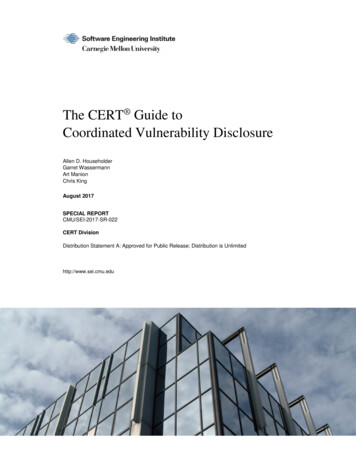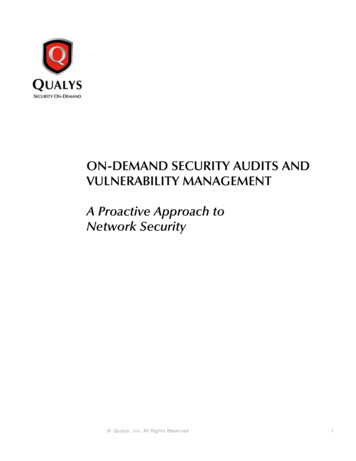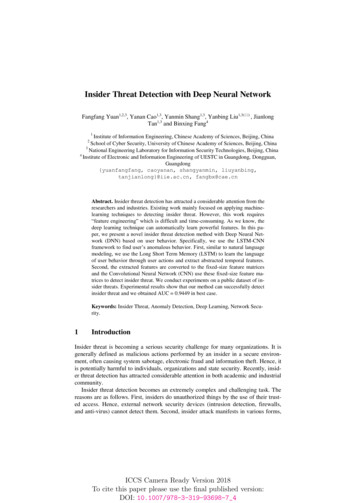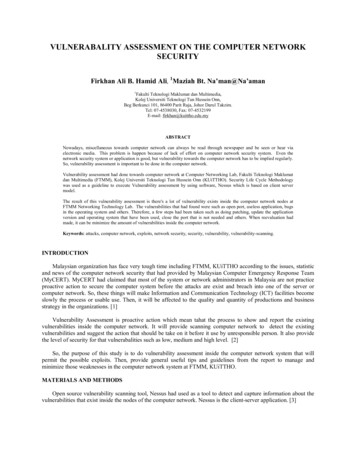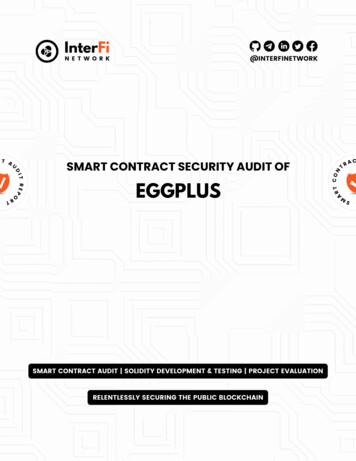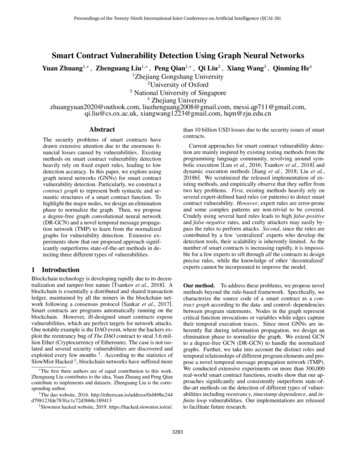
Transcription
Proceedings of the Twenty-Ninth International Joint Conference on Artificial Intelligence (IJCAI-20)Smart Contract Vulnerability Detection Using Graph Neural NetworksYuan Zhuang1, , Zhenguang Liu1, , Peng Qian1, , Qi Liu2 , Xiang Wang3 , Qinming He41Zhejiang Gongshang University2University of Oxford3National University of Singapore4Zhejiang Universityzhuangyuan2020@outlook.com, liuzhenguang2008@gmail.com, messi.qp711@gmail.com,qi.liu@cs.ox.ac.uk, xiangwang1223@gmail.com, hqm@zju.edu.cnAbstractthan 10 billion USD losses due to the security issues of smartcontracts.The security problems of smart contracts havedrawn extensive attention due to the enormous financial losses caused by vulnerabilities. Existingmethods on smart contract vulnerability detectionheavily rely on fixed expert rules, leading to lowdetection accuracy. In this paper, we explore usinggraph neural networks (GNNs) for smart contractvulnerability detection. Particularly, we construct acontract graph to represent both syntactic and semantic structures of a smart contract function. Tohighlight the major nodes, we design an eliminationphase to normalize the graph. Then, we proposea degree-free graph convolutional neural network(DR-GCN) and a novel temporal message propagation network (TMP) to learn from the normalizedgraphs for vulnerability detection. Extensive experiments show that our proposed approach significantly outperforms state-of-the-art methods in detecting three different types of vulnerabilities.1Current approaches for smart contract vulnerability detection are mainly inspired by existing testing methods from theprogramming language community, revolving around symbolic execution [Luu et al., 2016; Tsankov et al., 2018] anddynamic execution methods [Jiang et al., 2018; Liu et al.,2018b]. We scrutinized the released implementation of existing methods, and empirically observe that they suffer fromtwo key problems. First, existing methods heavily rely onseveral expert-defined hard rules (or patterns) to detect smartcontract vulnerability. However, expert rules are error-proneand some complex patterns are non-trivial to be covered.Crudely using several hard rules leads to high false-positiveand false-negative rates, and crafty attackers may easily bypass the rules to perform attacks. Second, since the rules arecontributed by a few ‘centralized’ experts who develop thedetection tools, their scalability is inherently limited. As thenumber of smart contracts is increasing rapidly, it is impossible for a few experts to sift through all the contracts to designprecise rules, while the knowledge of other ‘decentralized’experts cannot be incorporated to improve the model.IntroductionBlockchain technology is developing rapidly due to its decentralization and tamper-free nature [Tsankov et al., 2018]. Ablockchain is essentially a distributed and shared transactionledger, maintained by all the miners in the blockchain network following a consensus protocol [Sankar et al., 2017].Smart contracts are programs automatically running on theblockchain. However, ill-designed smart contracts exposevulnerabilities, which are perfect targets for network attacks.One notable example is the DAO event, where the hackers exploit the reentrancy bug of The DAO contract to steal 3.6 million Ether (Cryptocurrency of Ethereum). The case is not isolated and several security vulnerabilities are discovered andexploited every few months † . According to the statistics ofSlowMist Hacked ‡ , blockchain networks have suffered more The first three authors are of equal contribution to this work.Zhenguang Liu contributes to the idea, Yuan Zhuang and Peng Qiancontribute to implements and datasets. Zhenguang Liu is the corresponding author.†The dao website, 2016. 3fcc1c72d3bb8c189413‡Slowmist hacked website, 2019. https://hacked.slowmist.io/en/.3283Our method. To address these problems, we propose novelmethods beyond the rule-based framework. Specifically, wecharacterize the source code of a smart contract as a contract graph according to the data- and control- dependenciesbetween program statements. Nodes in the graph representcritical function invocations or variables while edges capturetheir temporal execution traces. Since most GNNs are inherently flat during information propagation, we design anelimination phase to normalize the graph. We extend GCNto a degree-free GCN (DR-GCN) to handle the normalizedgraphs. Further, we take into account the distinct roles andtemporal relationships of different program elements and propose a novel temporal message propagation network (TMP).We conducted extensive experiments on more than 300,000real-world smart contract functions, results show that our approaches significantly and consistently outperform state-ofthe-art methods on the detection of different types of vulnerabilities including reentrancy, timestamp dependence, and infinite loop vulnerabilities. Our implementations are releasedto facilitate future research.
Proceedings of the Twenty-Ninth International Joint Conference on Artificial Intelligence (IJCAI-20)Figure 1: The graph generation and normalization phases of our method. (a) shows the source code of a smart contract; (b) visualizes thegraph extracted from the source code. Nodes in circle denote major nodes and nodes in square represents secondary nodes. (c) demonstratesthe graph after normalization.Contributions. To summarize, our key contributions are: i)We introduce a novel temporal message propagation network(TMP) and a degree-free GCN (DR-GCN) to automaticallydetect smart contract vulnerabilities. ii) We propose to characterize the contract function source code as contact graphs,and explicitly normalize the graph for highlighting the keynodes. iii) Our methods set the new state-of-the-art performance on smart contract vulnerability detection, and overallprovide insights into the challenges and opportunities.2Problem StatementProblem formulation. Presented with the source code of asmart contract, we are interested in developing a fully automated approach that can detect vulnerabilities at the functionlevel. That is, we are to estimate the label ŷ for each smartcontract function SC, where ŷ 1 represents SC has a vulnerability of a certain type while ŷ 0 denotes SC is safe. Inthis paper, we focus on three types of vulnerabilities:Reentrancy is a well-known vulnerability that caused theinfamous DAO attack. In Ethereum, when a smart contractfunction F1 transfers money to a recipient contract C1 , thefallback function of C1 will be automatically triggered. C1may invoke back to F1 in its fallback function to reenter F1for stealing money. Since the current execution of F1 waitsfor the transfer to finish, C1 can make use of the intermediatestate F1 is in to succeed in stealing.Infinite loop is a common vulnerability in smart contracts.The program of a function may contain an iteration or loopwith no exit condition or the exit condition cannot be reached,i.e., an infinite loop. The fallback mechanism in smart contracts rises a new possibility of this non-termination bug,namely a cycled call between functions and the fallback function. For example, function A invokes function B with incorrect arguments, which will automatically trigger the execution of the fallback function in this contract. Suppose thefallback function further invokes function A, this will leadsto a call loop between A and the fallback function.Timestamp dependence vulnerability exists when a smartcontract uses the block timestamp as a triggering conditionto execute some critical operations, e.g., sending Ether or de-3284termining the winner of a game. The miner in Ethereum hasthe freedom to set the timestamp of a block within a shorttime interval ( 900 seconds) [Jiang et al., 2018]. Therefore,miners may manipulate the block timestamps to gain illegalbenefits.3Our MethodMethod overview. The overall architecture of our methodconsists of three phases: (1) a graph generation phase, whichextracts the control flow and data flow semantics from thesource code and explicitly models the fallback mechanism,(2) a graph normalization phase inspired by k-partite graph,and (3) novel message propagation networks for vulnerabilitymodeling and detection. Next, we introduce the three phases,respectively.3.1Graph GenerationExisting work [Allamanis et al., 2018] has shown that programs can be transformed into symbolic graph representations, which are able to preserve semantic relationships between program elements. Inspired by this, we formulate asmart contract function into a contract graph, and assign distinct roles to different program elements (nodes). Further, weconstruct edges by taking their temporal order into consideration. Figs. 1(a) & (b) demonstrate a contract snippet and thegraph constructed for its getBonus function, respectively.Our first insight is that different program elements in afunction are not of equal importance. Therefore, we extractthree categories of nodes, i.e., major nodes, secondary nodes,and fallback nodes.Major nodes construction. Major nodes symbolize the invocations to customized or built-in functions that are important for detecting the specific vulnerability. For example, forreentrancy vulnerability, a major node models the invocationto a transfer function or the built-in call.value function, whichis key to detect reentrancy. For timestamp dependence vulnerability, the built-in function invocation block.timestampis extracted as a major node. For infinite loop, all the customized functions within the contract are treated as major
Proceedings of the Twenty-Ninth International Joint Conference on Artificial Intelligence (IJCAI-20)SymbolAHRGIRITIFGBGNWHFRAGACFWFBSemantic Factassert{X}require{X}revertthrowif{X}if{.} else {X}if{.} then {X}while{X} do{.}for{X} do{.}assign{X}access{X}natural sequential relationshipsinteractions with fallback functionTypeControl-flow edgesData-flow edgesForward edgeFallback edgeTable 1: Semantic edges summarization. All edges are classifiedinto 4 types, namely control-flow, data-flow, forward, and fallback.nodes. Formally, we characterize all the critical functions asmajor nodes, which are denoted by M1 , M2 , . . . , Mn .Secondary nodes construction. While major nodes represent important invocations, secondary nodes are used tomodel critical variables, e.g., user balance and bonus flag.Formally, the critical variables are defined as secondary nodesS1 , S2 , . . . , Sn .Fallback node construction. Further, we construct a fallback node F to stimulate the fallback function of an attackcontract, which can interact with the function under test. Thefallback function is a special design in smart contracts, and isthe cause of many security vulnerabilities.Edges construction. We further construct edges to modelthe relationships between nodes. Each edge describes a paththat might be traversed through by the contract function under test, and the temporal number of the edge characterizesits order in the function. Specifically, the feature of an edgeis extracted as a tuple (Vs , Ve , o, t), where Vs and Ve represent its starting and end nodes, o denotes its temporal order,and t the edge type. To capture rich semantic dependenciesbetween nodes, we construct four types of edges, namely control flow, data flow, forward and fallback edges. The detailsof the semantic edges are listed in Table 1.3.2Contract Graph NormalizationMost graph neural networks are inherently flat when propagating information, ignoring that some nodes play more central roles than others. Moreover, different contract sourcecode yield distinct graphs, hindering the training of graphneural networks. Therefore, we propose a node eliminationprocess to normalize graphs.Nodes elimination. As introduced in Section 3.1, the node M of a graph is partitioned into major nodes {Mi }i 1 , sec M ondary nodes {Si }i 1 , and the fallback node F . We removeeach secondary node Si but pass the feature of Si to its nearestmajor node. Note that if Si has multiple nearest major nodes,its feature is passed to all of them. The fallback node is alsoremoved similar to the secondary node. The edges connecting to the removed node are preserved but with their startingor end node moving to the corresponding major node.3285Feature of major nodes. Features of major nodes are updated by aggregating features from their neighboring removed nodes. To distinguish between the original major nodeand its corresponding major node after aggregation, we denote the new major node of Mi as Vi . The feature of Vi iscomposed of three parts: i) self-feature, namely the featureof major node Mi ; ii) in-features, namely features of the sec P ondary nodes {Pj }j 1 that are merged to Mi and having apath pointing from Pj to Mi ; and iii) out-feature, namely fea Q tures of the secondary nodes {Qk }k 1 that are merged to Miand having a path directs from Qk from Mi . Fig. 1(c) illustrates the normalized graph of Fig. 1(b).3.3Message Propagation Neural NetworksIn this subsection, we first extend the GCN to a degree-freeGCN (DR-GCN), then propose a novel temporal messagepropagation network (TMP). Both the two proposed networkstake the normalized graph G of a smart contract function asinput, and output the label ŷ {0, 1} indicating whether thefunction has a vulnerability of a certain type.DR-GCN. [Kipf and Welling, 2017] proposes to apply convolutional neural networks to graph-structured data, whichdevelops a layer-wise propagation network as: 11Xl 1 σ D̂ 2 ÂD̂ 2 Xl Wl(1)where  A I is the adjacency matrix (A) enhanced withself-loops (I), Xl is the feature matrix of layer l, and Wl isa trainable weight matrix. In the equation, the diagonal nodedegree matrix D̂ is used to normalize Â. We first increasethe connectivity between nodes in the normalized graph G byusing the square of A. Then, we further take into accountthat the graph is already well normalized in our setting, andtherefore remove matrix D̂ from the equation. Finally, wearrive at the solution: Xl 1 σ (A2 I)Xl Wl .TMP. We also propose a TMP network, consisting of amessage propagation phase and a readout phase (Fig. 2).In the message propagation phase, TMP passes informationalong the edges successively by following their temporal order. Then, TMP computes a label for the entire graph G byusing a readout function, which aggregates the final states ofall nodes in G. Formally, G {V, E}, where V consists ofall the major nodes and E contains all the edges. Denote E {e1 , e2 , . . . , eN }, where ek represents the k th temporal edge.Message propagation phase. Messages are passed alongthe edges, one edge per time step. At time step 0, the hiddenstate h0i for each node Vi is initialized with the feature of Vi .At time step k, message flows through the k th temporal edgeek and updates the hidden state of Vek , namely the end nodeof ek . Particularly, message mk is computed basing on hsk ,the hidden state of the starting node of ek , and the edge typetk :xk hsk tkmk W k x k b k(2)(3)
Proceedings of the Twenty-Ninth International Joint Conference on Artificial Intelligence (IJCAI-20)Figure 2: The overall architecture of our proposed TMP. (a) The input normalized graph; b) The message propagation phase; (c) The readoutphase that outputs the vulnerability detection result.where denotes concatenation operation, matrix Wk andbias vector b are network parameters. The original messagexk contains information from the starting node of ek and edgeek itself, which are then transformed into a vector embeddingusing Wk and b. After receiving the message, the end nodeof ek updates its hidden state hek by aggregating informationfrom the incoming message and its previous state. Formally,hek is updated according to:ĥek tanh(U mk Zhek b1 )(4)0hek sof tmax(Rĥek b2 )(5)where U , Z, R are matrices, while b1 and b2 are bias vectors.Readout phase. After successively traversing all the edgesin G, TMP computes a label for G by reading out the finalhidden states of all nodes. Let hTi be the final hidden state ofthe ith node, we may generate the prediction label ŷ byŷ V Xf (hTi )(6)i 1where f is a mapping function, e.g., a neural network, and V denotes the number of major nodes. However, we foundthat the differences between the final hidden state hTi and theoriginal hidden state h0i are informative in the vulnerabilitydetection task. Therefore, we instead consider to compute ŷas follows:si hTi h0i(7)b(2)g )(8)(1)(2)oi sof tmax(Wo(2) (tanh(b(1)o Wo si )) bo )(9)gi sof tmax(Wg(2) (tanh(b(1)g Wg(1) si )) V ŷ XSigmoid(oigi )(10)i 1(1)(2)where denotes element-wise product. Wj , bj , and bj ,with subscript j {g, o} are model parameters to be learned.Both the two networks DR-GCN and TMP are trained forcontract vulnerability detection. During training, networksare fed with a large number of normalized graphs constructed3286from smart contract functions, together with their groundtruth labels. Then, the trained models are employed to absorb a normalized graph and yield a vulnerability detectionlabel. We would like to point out that we developed automation tools for converting source code to normalized graphs,therefore, the whole procedure is fully automated.4Experiments4.1Datasets and Experimental SettingsDatasets. Extensive experiments are conducted on all thesmart contracts that have source code on the Ethereum andVNT Chain platforms. We denote the two real-world smartcontract datasets as ESC (Ethereum Smart Contracts) andVSC (VNT chain Smart Contracts), respectively. ESC consists of 40,932 Ethereum smart contracts withroughly 307, 396 functions in total. Among the functions, around 5, 013 functions possess at least one invocation to call.value, making them potentially affectedby the reentrancy vulnerability. Around 4, 833 functionscontain the block.timestamp statement, making themsusceptible to the timestamp dependence vulnerability. VSC consists of 4, 170 smart contracts collected fromthe VNT Chain , roughly containing 13, 761 functions.VNT Chain is an experimental public blockchain platform proposed by companies and universities from Singapore, China, and Australia.Experimental settings. We compared our approaches(DR-GCN and TMP) with a total of twelve other methods,namely four existing smart-contract vulnerability detectionmethods (Oyente [Luu et al., 2016], Mythril [Mueller, 2017],Smartcheck [Tikhomirov et al., 2018], and Securify [Tsankovet al., 2018]), four neural network based methods (VanillaRNN, LSTM, GRU, and GCN), and four program loop detection methods (Jolt [Carbin et al., 2011], PDA [Ibing and Mai,2015], SMT [Kling et al., 2012], and Looper [Burnim et al.,2009]). For each dataset, we randomly pick 20% contractsas the training set while the remainings are utilized for thetesting set. In the comparison, metrics accuracy, recall, precision, and F1 score are all involved. In consideration of the Vntchain website, 2018. https://github.com/vntchain/go-vnt.
Proceedings of the Twenty-Ninth International Joint Conference on Artificial Intelligence (IJCAI-20)Timestamp dependenceReentrancyMethodsInfinite 274.10Table 2: Performance comparison in terms of accuracy, recall, precision, and F1 score. A total of fourteen methods are investigated in thecomparison, including state-of-the-art vulnerability detection methods, neural network based alternatives, our methods DR-GCN and TMP.‘–’ denotes not on(%)F1(%)Timestamp dependenceInfinite 8774.6174.3273.8974.10Table 3: Accuracy comparison between DR-GCN, TMP, and their variants on the three vulnerability detection tasks.distinct features of different platforms, experiments on reentrancy vulnerability and timestamp dependence vulnerabilityare conducted on the ESC dataset, while experiments on infinite loop vulnerability detection are conducted on the VSCdataset.4.2Comparison with Existing MethodsIn this subsection, we first benchmark the proposed approaches (DR-GCN and TMP) against state-of-the-art methods on the reentrancy, timestamp dependence, and infiniteloop vulnerabilities, respectively. Then, we compare our approaches with other neural network based methods.Comparison on Reentrancy Vulnerability DetectionFirst, we compare our DR-GCN and TMP methods withstate-of-the-art smart contract vulnerability detection methods, namely Oyente [Luu et al., 2016], Mythril [Mueller,2017], Smartcheck [Tikhomirov et al., 2018], and Securify[Tsankov et al., 2018], on the reentrancy vulnerability detection task. The performance of different methods is presentedin the left of Table 2, where metrics accuracy, recall, precision, and F1 score are engaged.From the quantitative results of Table 2, we have the following observations. First, we find that existing tools havenot yet achieved a satisfactory accuracy on reentrancy vulnerability detection, e.g., the state-of-the-art tool yields a 71.89%accuracy. Second, TMP outperforms state-of-the-art methodsby a large margin. More specifically, TMP achieves an accuracy of 84.48%, gaining a 12.39% accuracy improvementover state-of-the-art tools. Besides, the F1 score of TMP is24.54% higher than existing methods. Thirdly, DR-GCN alsoachieves better results than other existing methods in termsof all the four metrics. The strong empirical evidences revealthe great potential of applying graph neural networks to smartcontract vulnerability detection.3287Comparison on Timestamp Dependence VulnerabilityDetectionWe then compare the proposed methods with state-of-the-artsmart contract vulnerability detection tools on the timestampdependence vulnerability detection task. The comparison results are demonstrated in the middle of Table 2. The stateof-the-art method has obtained a 61.08% accuracy on timestamp dependence vulnerability detection, which is quite low.This may stem from the fact that most of existing methodsdetect timestamp dependence vulnerability by crudely checking whether there is block.timestamp statement in the function. Moreover, in consistent with the results on reentrancyvulnerability detection, TMP keeps delivering the best performance in terms of all the four metrics, while DR-GCN ranksthe second. In particular, TMP gains a 22.37% accuracy improvement over state-of-the-art method.We further look into the existing smart contract vulnerability detection tools to investigate the reasons behind the observations. Smartcheck fundamentally depends on a few rigidand simple logic rules to detect vulnerabilities, which leadsto low accuracy and F1 score. Oyente employs data flowanalysis to improve the accuracy, while its underlying patterns for detecting vulnerabilities are not so accurate. Regarding Mythril, it requires sophisticated techniques such as taintanalysis or manual audit, which attains a medium accuracy.Unlike other methods, Securify classifies smart contract functions into violations, warnings, and compliances, where violation denotes the function is guaranteed to have the vulnerability (positive), and compliance denotes the function is safe(negative). We treat all warnings as negative since users areusually attracted by violations while ignoring a lot of warnings. Securify performs better than other existing methods,but has a high false negative rate.Comparison on Infinite Loop Vulnerability DetectionFor the infinite loop vulnerability detection, we compare ourmethods against available tools including Jolt [Carbin et al.,
Proceedings of the Twenty-Ninth International Joint Conference on Artificial Intelligence (IJCAI-20)(a)(b)(c)(d)(e)(f)Figure 3: Visually comparison: (a) & (b) present comparison results of reentrancy vulnerability detection on the ESC dataset, while (c) & (d)present comparison results of timestamp dependence detection, (e) & (f) show comparison results of infinite loop vulnerability detection onthe VSC dataset. In (a) & (c), the 6 rows from front to back denote the Smartcheck, Oyente, Mythril, Securify, DR-GCN, and TMP methods,respectively. In (e), the 5 rows from front to back denote the Jolt, PDA, SMT, Looper, DR-GCN, and TMP methods, respectively. In (b) &(d) & (f), the 6 rows from front to back denote the Vanilla-RNN, LSTM, GRU, GCN, DR-GCN, and TMP methods, respectively. For eachrow in the figures, accuracy, recall, precision, and F1 score are respectively demonstrated from left to right.(a) Reentrancy(b) Timestamp(c) Infinite loopFigure 4: ROC analysis for DR-GCN, TMP, and their variants on the three vulnerability detection tasks. AUC stands for area under the curve.2011], SMT [Kling et al., 2012], PDA [Ibing and Mai, 2015],and Looper [Burnim et al., 2009]. We empirically find thatalmost all existing methods fail to detect the infinite loop bugcaused by the fallback mechanism of smart contracts. In contrast, our methods can successfully identify this vulnerability.This is because we explicitly model the fallback mechanismof smart contracts and consider data dependencies and control dependencies between program elements. Quantitativeresults are illustrated in the right of Table 2. From the table,we see that TMP consistently and significantly outperformsthe other methods on the infinite loop vulnerability detectiontask. In particular, TMP and DR-GCN respectively achieve a15.05% and 8.78% accuracy improvement over state-of-theart methods.We further visualize the comparison results in Fig. 3(a), (c),and (e). Fig. 3(a) and Fig. 3(c) present comparison resultsof reentrancy vulnerability detection and timestamp dependence vulnerability detection, respectively. The 6 rows (indifferent colors) from front to back denote the Smartcheck,Oyente, Mythril, Securify, DR-GCN, and TMP methods, respectively. For each row in the figures, accuracy, recall, precision, and F1 score are respectively demonstrated from leftto right. Fig. 3(e) shows comparison results of infinite loopvulnerability detection, where the the 6 rows from front toback denote the Jolt, PDA, SMT, Looper, DR-GCN, and TMPmethods, respectively. We can clearly observe that DR-GCNand TMP outperform existing methods.3288Comparison with Neural Network Based MethodsIn order to seek out which neural network architectures couldsucceed in smart contract vulnerability detection, we alsocompare our methods with other neural network alternatives.Specifically, Vanilla-RNN, LSTM, GRU, and GCN are compared with our DR-GCN and TMP networks. For fair comparison, all the methods are presented with the vector representation of the normalized graph extracted from the sourcecode and are required to detect the corresponding bugs. Weillustrate the results of different models in terms of accuracy,recall, precision, and F1 score in Table 2. Fig. 3(b), (d), and(f) further visualize the results.Interestingly, experimental results show that conventionalrecurrent neural networks Vanilla-RNN, LSTM, and GRUperform no better than existing vulnerability detection methods. In contrast, graph neural networks GCN, DR-GCN, andTMP, which are capable of handling graphs, achieve significantly better results than existing methods. This suggeststhat blindly treat the source code as a sequence is not suitable for the vulnerability detection task, while modeling thesource code into graphs and adopting graph neural networksis promising. We conjecture that conventional recurrent models lose valuable information from smart contract code sincethey ignore the structural information of contract programs,such as the data-flow and invocation relationships.We would like to highlight that the proposed TMP and DRGCN model consistently and significantly outperforms otherneural network models in terms of all the 4 metrics. BesidesTMP and DR-GCN, the GCN model performs the best. The
Proceedings of the Twenty-Ninth International Joint Conference on Artificial Intelligence (IJCAI-20)accuracies of GCN and DR-GCN are lower than TMP. Weattribute this to the fact that GCN fails to capture the temporalinformation induced by data flow and control flow, which isexplicitly addressed in our TMP model using ordered edges.4.3Study on The Effect of Graph NormalizationBy default TMP adopts the graph normalization module tohighlight the major nodes in the graph, it is interesting to seethe effect of removing this module. We removed the graphnormalization phase from TMP and DR-GCN, and comparedthem with the default TMP and DR-GCN. The two variantsare respectively denoted as TMP-WON and DR-GCN-WON,where WON is short for without normalization. Quantitative results are summarized in Table 3. We can see that withthe proposed normalization module, the performance of bothDR-GCN and TMP is better. For example, on the reentrancyvulnerability detection task, the DR-GCN model obtains a4.39% and 4.04% improvement in terms of accuracy and F1score, respectively,
contract, which can interact with the function under test. The fallback function is a special design in smart contracts, and is the cause of many security vulnerabilities. Edges construction. We further construct edges to model the relationships between nodes. Each edge describes a path that might be traversed through by the contract function un-
